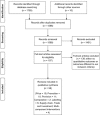The effects of policy actions to improve population dietary patterns and prevent diet-related non-communicable diseases: scoping review
- PMID: 27901036
- PMCID: PMC5470099
- DOI: 10.1038/ejcn.2016.234
The effects of policy actions to improve population dietary patterns and prevent diet-related non-communicable diseases: scoping review
Abstract
Poor diet generates a bigger non-communicable disease (NCD) burden than tobacco, alcohol and physical inactivity combined. We reviewed the potential effectiveness of policy actions to improve healthy food consumption and thus prevent NCDs. This scoping review focused on systematic and non-systematic reviews and categorised data using a seven-part framework: price, promotion, provision, composition, labelling, supply chain, trade/investment and multi-component interventions. We screened 1805 candidate publications and included 58 systematic and non-systematic reviews. Multi-component and price interventions appeared consistently powerful in improving healthy eating. Reformulation to reduce industrial trans fat intake also seemed very effective. Evidence on food supply chain, trade and investment studies was limited and merits further research. Food labelling and restrictions on provision or marketing of unhealthy foods were generally less effective with uncertain sustainability. Increasingly strong evidence is highlighting potentially powerful policies to improve diet and thus prevent NCDs, notably multi-component interventions, taxes, subsidies, elimination and perhaps trade agreements. The implications for policy makers are becoming clearer.
Conflict of interest statement
The authors declare no conflict of interest.
References
-
- WHO. Global Burden of Metabolic Risk Factors for Chronic Diseases Collaboration. Risk factor estimates for 2004. Cardiovascular disease, chronic kidney disease, and diabetes mortality burden of cardiometabolic risk factors from 1980 to 2010: a comparative risk assessment. Lancet Diabetes Endocrinol 2014; 2: 634–647. - PMC - PubMed
-
- Grier S, Bryant CA. Social marketing in public health. Annu Rev Public Health 2005; 26: 319–339. - PubMed
Publication types
MeSH terms
Grants and funding
LinkOut - more resources
Full Text Sources
Other Literature Sources


